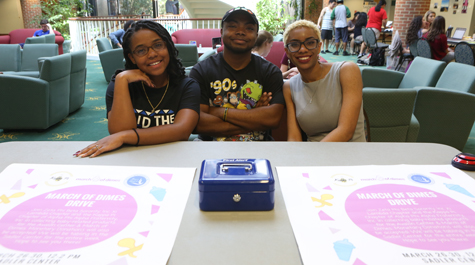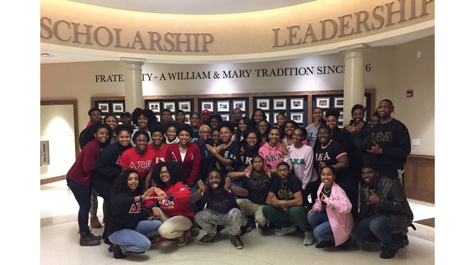Lifelong service: NPHC at W&M builds on tradition
When African-American students were finally admitted to predominantly white colleges and universities in the United States, segregation persisted in many forms, including exclusion from the Greek system. In response, the students created their own fraternities and sororities with a special interest in service, civic engagement and the empowerment of the African-American community.
Many of those organizations still thrive today at countless institutions of higher education under the auspices of National Pan-Hellenic Council. At William & Mary, just 50 years after the university accepted its first African-American residential students, six NPHC chapter organizations continue the traditions started by their founders while evolving to address modern issues. The groups will gather for the NPHC Yard Show, which includes step and other performances, at 7 p.m. on April 26 in the Martha Wren Briggs Amphitheatre at Lake Matoaka.
{{youtube:medium:right|KXCLR_yu_yg, Students showcase "strolling" during the 2015 multicultural fair}}
“It’s very important that we remain at William & Mary, a predominantly white institution, to have that space for African-American students to feel at home or express themselves or even to show the campus that we are a part of this community and we are engaging with the community,” said Mikayla Sherman ’18, president of the Mu Upsilon Chapter of Delta Sigma Theta Sorority, Inc.
“I feel like the National Pan-Hellenic Council as a whole is extremely important just to help African-Americans no matter where they come from to know that they have a home away from home.”
History
Established in 1930 to encourage collaboration among the organizations, the National Pan-Hellenic Council currently includes nine fraternities and sororities, collectively known as the “Divine Nine”: Alpha Phi Alpha Fraternity, Inc., Alpha Kappa Alpha Sorority, Inc., Kappa Alpha Psi Fraternity, Inc., Omega Psi Phi Fraternity, Inc., Delta Sigma Theta Sorority, Inc., Phi Beta Sigma Fraternity, Inc., Zeta Phi Beta Sorority, Inc., Sigma Gamma Rho Sorority, Inc., and Iota Phi Theta Fraternity, Inc.
At William & Mary — where the first collegiate Greek-letter organization, Phi Beta Kappa, was founded in 1776 — the Kappa Pi Chapter of Alpha Phi Alpha, charted in 1975, was the first NPHC fraternity to be established. The Mu Upsilon Chapter of Delta Sigma Theta followed in 1976, becoming the university’s first NPHC sorority. As the number of African-American students at the university increased, so did the NPHC chapters until, eventually, eight of the nine organizations were chartered at W&M by the early 2000s. Both of the original NPHC chapters are still active today along with two other fraternities — the Xi Theta Chapter of Kappa Alpha Psi and the Alpha Delta Sigma Chapter of Omega Psi Phi — and two sororities, the Nu Chi Chapter of Alpha Kappa Alpha and Xi Lambda Chapter of Zeta Phi Beta. The organizations today are open to students of all ethnicities.
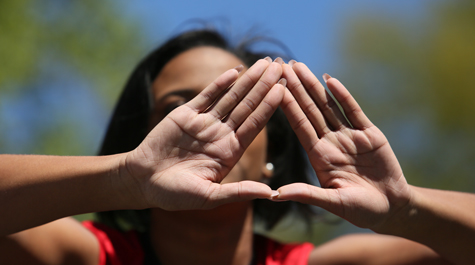 While each of the groups has its own areas of emphasis, NPHC organizations overall have a unique focus on a continued commitment to public service beyond the collegiate experience — for a lifetime, said Chon Glover M.Ed. ’99, Ed.D. ’06, W&M’s chief diversity officer and a member of the Delta Sigma Theta Sorority, Inc. Williamsburg alumnae chapter. There is also a strong emphasis on leadership, empowerment, uplift through sisterhood and brotherhood, she said, adding that people can join NPHC organizations as a college student or as a graduate, as she did.
While each of the groups has its own areas of emphasis, NPHC organizations overall have a unique focus on a continued commitment to public service beyond the collegiate experience — for a lifetime, said Chon Glover M.Ed. ’99, Ed.D. ’06, W&M’s chief diversity officer and a member of the Delta Sigma Theta Sorority, Inc. Williamsburg alumnae chapter. There is also a strong emphasis on leadership, empowerment, uplift through sisterhood and brotherhood, she said, adding that people can join NPHC organizations as a college student or as a graduate, as she did.
For example, the Deltas at W&M host the Delta GEMS and Delta Academy youth service and mentorship programs for local children as well as an annual Halloween party that raises money and canned goods for the Peninsula Food Bank, among other efforts.
The other NPHC organizations at W&M also have unique service projects, which sometimes overlap with one another. The Alphas, for example, joined with the Zetas recently to host a collection for the March of Dimes. The organizations also come together to host annual events like Stomp Fest and special events, like last year’s “Black Love” discussion.
But service was one of the main draws for Zach Sims, vice president of the Kappa Pi Chapter of Alpha Phi Alpha Fraternity, Inc., who has worked to mentor youth since he was in high school. Today, with his fraternity, he continues that work through the Distinguished Gentlemen mentoring program.
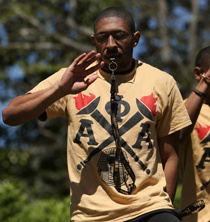 “It’s our biggest community initiative and the one closest to my heart,” he said, adding that he wants to make sure that young men have positive male role models in their lives.
“It’s our biggest community initiative and the one closest to my heart,” he said, adding that he wants to make sure that young men have positive male role models in their lives.
“If they don’t have that type of male role model in their lives, they could potentially fall by the wayside, and that’s something that I definitely don’t want to see happening to any of the young men,” he said. “I know if we can just continue to touch their lives, it will help their development as well.”
Benefits of membership
While NPHC organizations at the university benefit both the W&M and local communities, they also offer their members leadership opportunities as well as lifelong entry to a brotherhood or sisterhood whose members span the world.
“When I joined this organization, I joined because I believe in what the founders’ vision was, I believe in its work and I believe in what I could do in moving those things forward,” said Glover, who grew up without siblings but has found unlimited sisters in her sorority. “So when you meet another Delta, you know that that’s what she’s about, too, and there’s an instant connection.”
Sims — who is also a member of the football team and involved in numerous other activities, including WMSURE — said that helping lead the fraternity has been like running a small business. He has benefited from networking with the brothers who came before him, one of whom provided him with an internship. Aliyah Wooten ’18, vice president of the Mu Upsilon Chapter of Delta Sigma Theta Sorority, Inc., likened sisterhood to having a full-time job, but one she wouldn’t want to give up.
“I love my full-time job. It’s very involved, but it’s very rewarding at the end of the day,” said Wooten.
The organizations also offer African-American students at predominantly white institutions like W&M a chance to connect with people of the same identity, providing them spaces to speak freely.
“I think NPHC has the ability to bring students together where there’s no judgment or we can talk about controversial issues that we understand to be true and won’t be kind of knocked down like you’re being too emotional about this, or too sensitive about this,” said Wooten.
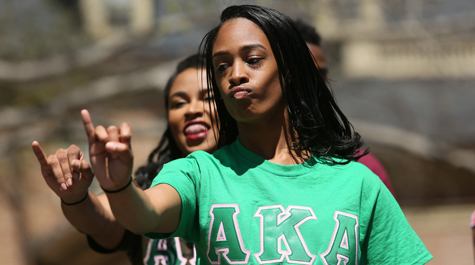 Sims, too, said that the NPHC organizations help give the black community on campus a voice.
Sims, too, said that the NPHC organizations help give the black community on campus a voice.
“I think the NPHC is a group of organizations that provides not only the black community but the entire campus community with a sense of solidarity, a sense of understanding that while we may have different activities going on in just our daily lives and are separate organizations, we’re all working toward one common goal.
“I also think that NPHC has sort of helped W&M open its eyes a little bit to areas in which they can improve, as well,” he said. “Any time we’re able to express our opinion to our advisors, that gives them an understanding of where a different group of people is coming from, gives them an insight into a mindset they may not be able to understand at the time but they can at least respect and evaluate and try to institute some things so we all feel like we’re on an equal playing field.”
Wooten agreed.
“We come from a marginalized group of people but this marginalized group of people is very persistent and determined to ensure that every minority of color has a place here and feels valued here, and Mu Upsilon specifically is going to ensure that W&M is held accountable to the things they are preaching to students,” she said. “We are going to make sure this institution is going to be held accountable in terms of action, and I think that’s very valuable.”
As the NPHC organizations look toward the future, Wooten hopes to see collaborations among them continue to increase.
“As a council, we are working toward something greater,” she said. “Though we each belong to our separate organizations, we at the end of the day share a common goal, so I think once we figure out how to work together and better align our own values and objectives, we are going to be a force to be reckoned with on this campus. I think we are moving toward progress, and that’s really good.”















